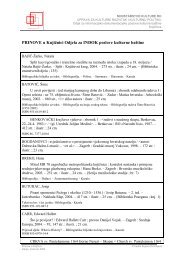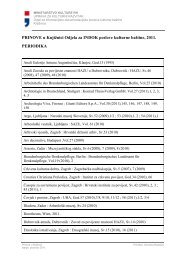Gašpina mlinica u Solinu - Ministarstvo kulture RH
Gašpina mlinica u Solinu - Ministarstvo kulture RH
Gašpina mlinica u Solinu - Ministarstvo kulture RH
Create successful ePaper yourself
Turn your PDF publications into a flip-book with our unique Google optimized e-Paper software.
Literatura<br />
Ćuk, J. (1925.): Požeško plemstvo i požeška županija od<br />
doba prvih sačuvanih imena i naziva do polovice četrnaestog<br />
vijeka, Rad JAZU, (231)34, 50-58, Zagreb<br />
Badurina, A. (2006.): Leksikon ikonografije liturgike i simbolike<br />
zapadnog kršćanstva, Zagreb<br />
Filipec, K. (2008.): Po svetištu Majke Božje Gorske u Loboru,<br />
Arheološko-povijesni vodič, Zagreb<br />
Goss, V. P. - Šepić, N. (2007.): A note on some Churches<br />
with Rectangular Sanctuary in Medieval Slavonia, Peristil.<br />
(50):21-40, Zagreb<br />
Horvat, A. (1984./85.): Prilog tipološkoj klasifikaciji romaničkih<br />
crkava kontinentalne Hrvatske, Bulletin 1 (55<br />
i 56): str. 70, Zagreb<br />
Horvat, Z. (1989.): Strukture gotičke arhitekture, Zagreb<br />
Horvat, Z. (1992.): Katalog gotičkih profilacija, Zagreb<br />
Mažuran, I. (1958.): Turska osvajanja, Osječki zbornik,<br />
(6), Osijek<br />
McClendon, Ch. (2005.): The orginis of Medieval Architecture,<br />
New Haven and London<br />
Pamić, J. (1991.): Gornjokredne bazaltoidne i piroklastične<br />
stijene iz voćinske vulkanske mase na Papuku (Slavonija,<br />
sjeverna Hrvatska), Geološki vjesnik, (44) Zagreb<br />
Summary<br />
CONSERVATION RESEARCH AND RENOVATION OF<br />
THE CHURCH OF ST. LUKE IN SREDNJI LIPOVAC<br />
The Church of St. Luke in Srednji Lipovac is a protected cultural monument<br />
entered in the Registry of Cultural Property of the Republic of<br />
Croatia, List of Protected Cultural Property, no. Z-1299. Conservation<br />
research on the architectural corpus of the church has contributed<br />
to new insights into the stages of construction and the stylistic and<br />
morphological characteristics of this ecclesiastical building. The<br />
Church of St. Luke belongs to the corpus of single-nave ecclesiastical<br />
buildings with rectangular sanctuaries, built during the second<br />
half of the 13th century and early 14th century. One characteristic<br />
of these buildings is evidence in their structure and forms of a socalled<br />
transitional style. The entire 13th century was characterised<br />
by the parallel domination of Romanesque and Gothic architecture,<br />
but some buildings display an overlap, which in architectural terms<br />
is known as transitional style. In Croatia, this is particularly apparent<br />
at the end of the 13th century, in examples of smaller ecclesiastical<br />
buildings in rural architecture. In these buildings, the basic Romanesque<br />
concept used for the shape of the windows was adapted to<br />
suit newer, Gothic ideas. Instead of simple, semicircular sanctuaries,<br />
rectangular ones were introduced, with simple cross-rib vaults. The<br />
Church of St. Luke was built on an elevated site on the south slopes<br />
of the Požega Heights. The area has been inhabited since classical<br />
times, according to preliminary archaeological research findings.<br />
The site with the church stands out from the surrounding landscape<br />
because of its dominant spatial position, and this is why the location<br />
was of great geographical and strategic significance throughout the<br />
Konzervatorsko istraživanje i obnova crkve sv. Luke u Srednjem Lipovcu | 145<br />
Pamić, J.; Belak, M.; Slovenec, D., (1992.): Donjomiocenski<br />
trahiandeziti (šošoniti) Krndije u Slavoniji (sjeverna<br />
Hrvatska), Rad HAZU, Zagreb<br />
Sršan, S. (1995.): Katoličke župe u istočnoj Hrvatskoj 1733/34.<br />
god. Osijek<br />
Stopar, I. (1987.): Karolinška arhitektura na Slovenskom,<br />
Ljubljana<br />
Vukičević-Samaržija, D. (1986.): Sakralna gotička arhitektura<br />
u Slavoniji, Zagreb<br />
Vukičević-Samaržija, D. (1993.): Gotičke crkve Hrvatskog<br />
Zagorja, Zagreb<br />
Zadnikar, M. (1982.): Romanika v Sloveniji-tipologija i morfologija<br />
sakralne arhitekture, Ljubljana<br />
KRATICE USTANOVA<br />
AŽNK – Arhiv župnog ureda Nova Kapela<br />
AFSP – Arhiv Franjevačkog samostana sv. Duha u Požegi<br />
MK<strong>RH</strong>-AKOSB – <strong>Ministarstvo</strong> <strong>kulture</strong> Republike Hrvatske,<br />
Arhiv Konzervatorskog odjela Slavonski Brod<br />
MK<strong>RH</strong>-AKOS – <strong>Ministarstvo</strong> <strong>kulture</strong> Republike Hrvatske,<br />
Arhiv Konzervatorskog odjela<br />
GM-NG – Gradski muzej Nova Gradiška<br />
Middle Ages. The turbulent history of the church is borne out by<br />
many sketches engraved on the cornerstones of the sanctuary. The<br />
characteristic formation of the rectangular sanctuary is shown by<br />
the under-girding and reinforcement of the north wall, indicating<br />
the potential to raise the walls higher. Although the Church of St.<br />
Luke lost its original Early Gothic architectural dimensions to Baroque<br />
and Historicist renovations, the results of conservation research work<br />
have revealed some transitional style elements in the design of the<br />
ground-plan, in the use of certain architectural details (fragments<br />
of the stone doorposts), in determining the geometry of the wall<br />
niche in the rear wall of the rectangular sanctuary, and in other details<br />
in which a 3:4:5 sided triangle and a ratio of 1:2 are used (sl.15).<br />
Among the findings of conservation research, the discovery of<br />
Early Gothic frescoes in the sanctuary stand out, in which the central<br />
composition is positioned in the wall niche in the rear wall. The<br />
wall niche depicts the church’s patron, St. Luke the Evangelist, with<br />
St. Paul and a vine. On the south lateral face of the niche, there is a<br />
unique iconographic Early Gothic composition, painted according<br />
to a selected theme, full of symbolism, showing the conversion of St.<br />
Paul the Apostle. The saint, who was called Saul before his conversion<br />
to Christianity, is depicted in an expressive scene with a vine, one of<br />
the most vivid Biblical symbols, signifying the relationship between<br />
God and the Church, and at the same time, a phytomorphic symbol<br />
of Christ. Saul, who would later become the Apostle Paul, is painted<br />
in the central part of the south lateral face, in semi-profile, his left








